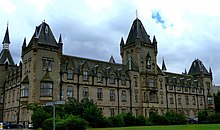Major Rohde Hawkins
Major Rohde Hawkins | |
|---|---|
 Hawkins in middle age, ca 1860 | |
| Born | 4 February 1821 Nutfield, Surrey, England |
| Died | 19 October 1884 Holmwood, Surrey, England |
| Resting place | Holmwood, Surrey, England |
| Nationality | English |
| Education | Thomas Cubitt; Edward Blore |
| Occupation | Architect |
| Employer(s) | self-employed; Privy Council |
| Spouse | Mary Littledale Greenwood |
| Children | – |
| Parent(s) | Edward Hawkins, Eliza Rohde |
Major Rohde Hawkins (born 4 February 1821 in Nutfield, Surrey; died 19 October 1884, Holmwood, Surrey)[1] was an English architect of the Victorian period. He is known for the schools and churches that he built.
Note: Both his given names "Major" and "Rohde" frequently cause difficulty; he was not an army major, and Rohde was his mother's maiden name: she was of a German family.
Family life
[edit]
Hawkins was the third son of numismatist and keeper of antiquities at the British Museum, Edward Hawkins (1780–1867) and Eliza Rohde, who had married on 29 September 1806.[2]
Hawkins was educated at Charterhouse School from 1831 to 1837; the school was then still part of the London Charterhouse in Finsbury.[1]
He was engaged by John Greenwood, a Yorkshire mill owner and politician at Swarcliffe, to rebuild Swarcliffe Hall in 1848.[1] Hawkins became close enough to the Greenwood family to marry John Greenwood's granddaughter, Mary Littledale Greenwood of Holmwood, Surrey,[1] on 4 August 1853.[3] Mary was the younger sister of John Greenwood.[4] John Bowyer Nichols and sons, London, 1858. A friend of the Greenwoods wrote effusively: "Mr Hawkins married our great friend John Greenwoods sister. He is one of the 1st Architects of the day. He is the Government architect for all these schools &c &c."[5]
Hawkins and his wife Mary lived at Redlands, South Holmwood,[1] which he designed.[4] He and his wife are both buried at St Mary Magdalene's Church, Holmwood, which he also designed, and where there is a memorial window to him.[1]
He was gazetted as Captain in the Queen's (Westminster) Rifle Volunteer Corps on 25 February 1860.[6]
Career
[edit]
Hawkins studied under the wealthy London architect Thomas Cubitt,[7] designer of Queen Victoria's Osborne House in the Isle of Wight. Hawkins then worked for the architect Edward Blore, designer of Buckingham Palace.[8] He then explored his father's interest in antiquities, spending time studying in Asia Minor (now Turkey).[9]
Hawkins is known today mainly for schools such as the Châteauesque Royal Victoria Patriotic Building in Wandsworth[10] and Gothic style churches.[9] The Builder described him as "both a skilful artist and a thorough English gentleman".[11]
From 1854 to his death he was employed as architect to the Privy Council's Education Department, alongside his private work.[9]
After his death, an auction of his "Objects of Art" on 9 June 1891 by Christie, Manson & Woods included ancient Chinese Cloisonné enamels, Japanese ivory carvings, bijouterie, old Persian, Venetian and French metal work, and Old Nankin, powdered blue and other enamelled Chinese porcelain.[12]
Buildings
[edit]- Swarcliffe Hall, Yorkshire (1848)[13]
- Hunt's Hall (Guy's Hospital, London) (1853)[1]
- Bodle Street Green, East Sussex (1853)[9]
- St James, Lode, Cambridgeshire (1853)
- St James' Church, Birstwith (1857)
- St Paul's Church, Burdett Row, Bow, London (1858) (destroyed World War II)[1]
- Royal Victoria Patriotic Building, Wandsworth, London (1859)[10]
- St Michael's Church, Star Street, Paddington, London (1860–1861) (destroyed World War II)[1]
- St Michael and All Angels Church, Mount Dinham, Exeter (1865–1868)[14]
- St Antony's Chapel, Cowley, Devon (1867–1868)[15]
- Fairwarp, East Sussex (1867–1871)[9]
- St John the Evangelist's Church, Holmwood, Surrey (1874–1875)[16]
- Redlands, South Holmwood, Surrey. c.1867
Bibliography
[edit]- Green, Lionel. Church Spires and Major Rohde Hawkins. Dorking History, (2000), pages 40–41. ref
References
[edit]- ^ a b c d e f g h i Mary Littledale Greenwood. Retrieved 9 June 2012.
- ^ Dictionary of National Biography, Hawkins, Edward (1780–1867), numismatist and antiquary, by W. W. Wroth. 1891.
- ^ Nichols, John Gough. The Topographer and genealogist (Volume 3).
- ^ a b "Redlands". Michael D. Heath-Caldwell (architect). Retrieved 29 October 2012.
- ^ Letter from E. Louisa Marsh re Hawkins. PB101067, dated ca 1856/7. Retrieved 10 June 2012.
- ^ "The London Gazette" (PDF). 20 March 1860. pp. A2, 1139. Retrieved 9 June 2012.
- ^ "Architects and Artists". T Cubitt. Sussex Parish Churches. 2012. Archived from the original on 5 March 2012. Retrieved 9 June 2012.
- ^ "Architects and Artists". E Blore. Sussex Parish Churches. 2012. Archived from the original on 5 March 2012. Retrieved 9 June 2012.
- ^ a b c d e "Architects and Artists". M R Hawkins. Sussex Parish Churches. 2012. Archived from the original on 2 April 2012. Retrieved 9 June 2012.
- ^ a b British Listed Buildings: Former Royal Victoria Patriotic School, Wandsworth. Retrieved 8 June 2012.
- ^ Obituary, The Builder, 6 December 1884.
- ^ "Sales by Auction". Property. The Times. No. 33340. London. 2 June 1891. p. 16. Retrieved 8 February 2018.
- ^ Families connected to Keighley history Archived 23 December 2012 at archive.today. Retrieved 10 June 2012.
- ^ St Michael's, Mount Dinham, Exeter
- ^ Cowley, Exeter, Grade II listed as "St Leonard's".
- ^ "St John the Evangelist, Holmwood, Surrey". Archived from the original on 9 February 2012. Retrieved 9 June 2012.
